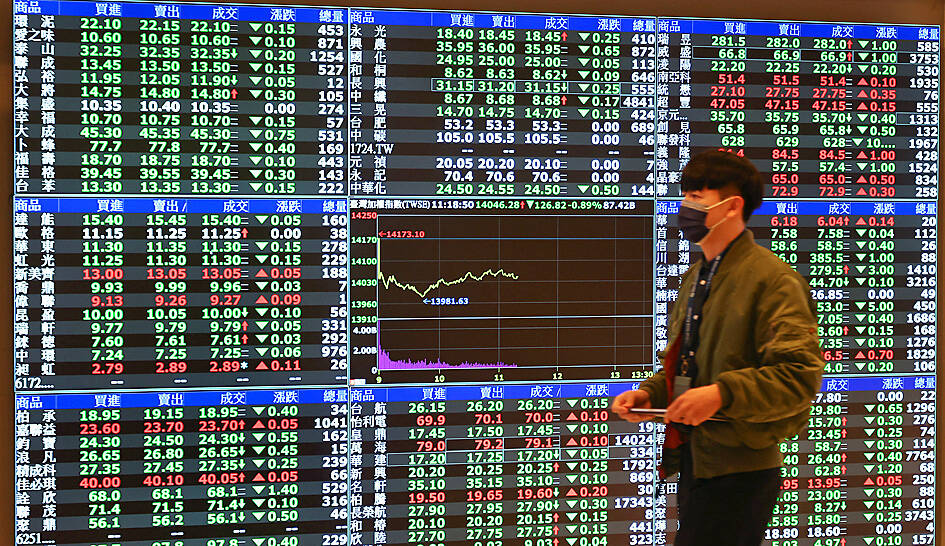Corporate earnings and business outlook at listed firms would dictate the local equity market’s direction this week, while investors would especially be waiting for the Taiwan Semiconductor Manufacturing Co (TSMC, 台積電) investors’ conference scheduled for Thursday, equity strategists said.
Despite concerns over a resurgence of COVID-19 in China and its effects on the global economy, market movements this week might follow the activities of foreign institutional investors, who bought a net NT$6.61 billion (US$215.3 million) of shares on the main board in this year’s first trading week, strategists said.
Foreign investors last year sold a net NT$1.23 trillion of shares, the highest amount on record.

Photo: CNA
Flat-panel maker Innolux Corp (群創), Powerchip Semiconductor Manufacturing Corp (力積電) and Shin Kong Financial Holding Co (新光金控) were the top three stocks bought by foreign institutional investors last week, with financial stocks making up five of the top 10, Taiwan Stock Exchange data showed.
The TAIEX on Friday closed up 0.51 percent at 14,373.34 points for a weekly increase of 1.67 percent as local and foreign institutional investors bought shares, exchange data showed.
Domestic proprietary traders last week added a net NT$3.17 billion of local shares and investment trust firms added a net NT$2.62 billion, exchange data showed.
Electronics shares were last week’s best performers with a 2.22 percent gain, followed by financial shares, which rose 1.63 percent, PGIM Securities Investment Trust Enterprise Co (PGIM, 保德信投信) analyst Sun Chuan-shu (孫傳恕) said in an investment note on Friday.
Electronics stocks often perform well in January, Sun said, citing historical patterns.
However, as the Lunar New Year holiday this year is earlier than usual, fund managers are focusing on short-term trading, he said, adding that the chances of seeing big moves in the market are low.
Taiwanese stocks are expected to face headwinds in the first half of this year, Sun said, citing a slowdown in the manufacturing purchasing managers’ index (PMI), a downward revision in profit forecasts for technology stocks and recession concerns in major economies.
While the TAIEX has stayed above 14,000 points in recent sessions, it would need more vigor to stage a substantial rebound, which is unlikely ahead of the Lunar New Year holiday, while selling in small and mid-cap stocks might occur ahead of the week-long holiday, SinoPac Securities Investment Service Corp (永豐投顧) said in a separate note.
It is normal for investors to trim their exposure ahead of long holidays, SinoPac said.
Tuesday next week is the last trading day before the holiday.
Equity markets in Taiwan are to reopen on Jan. 30.
If TSMC and smartphone camera lens maker Largan Precision Co (大立光) reveal positive business guidance at their investors’ conferences on Thursday, it could support their stock prices and serve as a catalyst for local shares to move up in the short term, SinoPac said.
Investors might also take their cue from financial results released by other local companies this week. Networking chip supplier Realtek Semiconductor Corp (瑞昱半導體), DRAM chipmaker Nanya Technology Corp (南亞科技) and Formosa Plastics Group’s (台塑集團) four major subsidiaries are among the companies that are to report their earnings this week.

The DBS Foundation yesterday announced the launch of two flagship programs, “Silver Motion” and “Happier Caregiver, Healthier Seniors,” in partnership with CCILU Ltd, Hondao Senior Citizens’ Welfare Foundation and the Garden of Hope Foundation to help Taiwan face the challenges of a rapidly aging population. The foundation said it would invest S$4.91 million (US$3.8 million) over three years to foster inclusion and resilience in an aging society. “Aging may bring challenges, but it also brings opportunities. With many Asian markets rapidly becoming super-aged, the DBS Foundation is working with a regional ecosystem of like-minded partners across the private, public and people sectors

Taiwan Semiconductor Manufacturing Co (TSMC, 台積電) has secured three construction permits for its plan to build a state-of-the-art A14 wafer fab in Taichung, and is likely to start construction soon, the Central Taiwan Science Park Bureau said yesterday. Speaking with CNA, Wang Chun-chieh (王俊傑), deputy director general of the science park bureau, said the world’s largest contract chipmaker has received three construction permits — one to build a fab to roll out sophisticated chips, another to build a central utility plant to provide water and electricity for the facility and the other to build three office buildings. With the three permits, TSMC

BREAKTHROUGH TECH: Powertech expects its fan-out PLP system to become mainstream, saying it can offer three-times greater production throughput Chip packaging service provider Powertech Technology Inc (力成科技) plans to more than double its capital expenditures next year to more than NT$40 billion (US$1.31 billion) as demand for its new panel-level packaging (PLP) technology, primarily used in chips for artificial intelligence (AI) applications, has greatly exceeded what it can supply. A significant portion of the budget, about US$1 billion, would be earmarked for fan-out PLP technology, Powertech told investors yesterday. Its heavy investment in fan-out PLP technology over the past 10 years is expected to bear fruit in 2027 after the technology enters volume production, it said, adding that the tech would

YEAR-END BOOST: The holiday shopping season in the US and Europe, combined with rising demand for AI applications, is expected to drive exports to a new high, the NDC said Taiwan’s business climate monitor improved last month, transitioning from steady growth for the first time in five months, as robust global demand for artificial intelligence (AI) products and new iPhone shipments boosted exports and corporate sales, the National Development Council (NDC) said yesterday. The council uses a five-color system to measure the nation’s economic state, with “green” indicating steady growth, “red” suggesting a boom and “blue” reflecting a recession. “Yellow-red” and “yellow-blue” suggest a transition to a stronger or weaker condition. The total score of the monitor’s composite index rose to 35 points from a revised 31 in August, ending a four-month